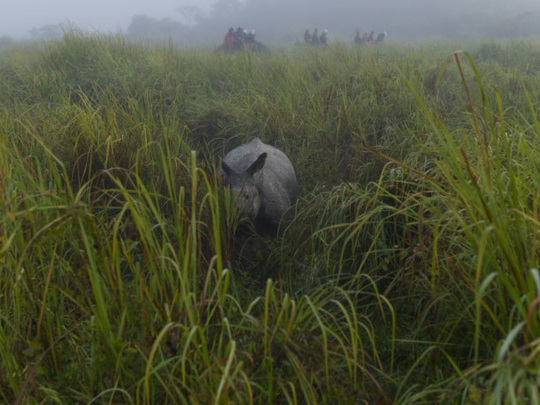
Even if you’ve only ever visited Kaziranga National Park by armchair, you’ll know that this Unesco World Heritage Site in the state of Assam in north-east India is home to two-third of the world’s great one-horned rhinoceros. And in our impulsive decision to make the journey to see these majestic animals in the wild, we cut ourselves off from the usual holiday markers — room service, shopping malls, spa treatments, fine-dining and predictable Wi-Fi.
A wise man told me once — the best journeys are usually taken in the opposite direction of the herd. And Kaziranga is undoubtedly the other Eden. Jeep safaris through the park’s different zones at dawn and in the late afternoon are the best way to get a grand tour of the place, as they cover the largest territory in the shortest time.
The park is divided into four zones — the central zone or Kaziranga Range, western or Bagori Range, eastern or Agaratoli Range, and the Burapahar Range. The central zone is most popular, so book in advance. But whatever zone you end up visiting, it’s likely you’ll take enough photographs to cover a wall. Taking pictures of the rhino, elephant and wild buffalo are the rule and the Royal Bengal Tiger, if you see one, is the icing on the cake.
Journey into the heartland
Our initial late-evening drive took us through the western zone, past rivulets and shallow lakes and along semi-evergreen, tropical, moist, forested highlands that blend into marshes. The ranger, ignited by the beauty around him, narrated a steady stream of enthralling stories — of times when the rhino population was dwindling dramatically because of large-scale poaching for the horn, a prized ingredient in Chinese medicine. With pride in his youthful voice, he expressed great faith in the conservation measures being put in place and anti-poaching punishment laws. “Visiting the park and not seeing the rhinos would be like going on a journey and missing the main attraction,” he said.
When we asked to see some rhinos, he turned to us dismayed — couldn’t we just enjoy the park for its open savannah grasslands, sunshine, the fish eagle and storks? Nonetheless he tried to accommodate our request. Sage exchanges and gestures between the drivers, in a codified language that’s obviously been used countless times, led us to a solitary one-horned beast lying in the marsh like an overstuffed cigar.
It’s hard to forget your first sighting of a rhino in the wild. The mammal looks armoured and from the Jurassic period, almost as if forged out of some ancient archetypal memory. Our specimen looked at us, flicked his tail and returned to his mud bath. Clearly he is accustomed to travellers intent on getting the shots. By the time the evening turned into a soft pink shade, I stopped mentally repeating the list of things I had to see. I was satisfied to just linger in a halted jeep, watching spotted deer at play or a majestic tree swaying in the breeze. My clocks were reset to Kaziranga time.
The morning after
The experience that has visitors biting their nails is heading into the marshes and elephant grass on elephantback in pursuit of the one-horned rhinoceros. To take this journey we set out at 5am — cold and bundled up in blankets and mufflers. The silence, punctuated only by birdsong, is a force in itself and deeply compelling.
We strained our eyes and ears to spot those elusive rhino scratches, footmarks and dung or listening, and catch their grunts, squeaks and wails. In the wild, security lies in numbers, and we held our breath in excitement when the herd of elephants we were travelling on closed >
in on a cluster of rhinos without frightening them. We spotted a mother with her babies, a couple of rhinos sitting together and lone rangers navigating the grass. Though massive in size, these beasts were tiny specks on the vast landscape.
And then out of nowhere, a mid-sized rhino, clearly annoyed at our voyeurism, made its way towards us, his horn pointing ominously to the sky. We quaked, feeling for that fleeting moment like prey and stricken by the possibility of not living to tell this tale.
The mahout however handled the situation with aplomb, quietly steering the elephants aside. I envied his connection with the earth and animals and figured that in the face of a potential rhinoceros confrontation I would trade all my degrees and carefully worked-out career plans for his rootedness and practical knowledge in a heartbeat.
Riding further, splashing through shallow ponds towards a large meadow, we came across at least two dozen barasingha (Eastern swamp deer) frolicking about. We were all mesmerised, save one gentleman on an adjoining elephant, who was more affected than the rest of us.
This was his sixth visit to Kaziranga. Clearly each visit had transformed him as a person, and none of them sated his desire for more — be it sighting a tusker in a hurry, or the wait to see a tiger for two days.
As he dismounted his elephant, I heard him whisper: “Dear Kaziranga, thank you for making me feel humbled, inspired and full of childlike wonder all at once.” n






